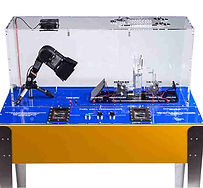E-mail: vandyk.kobus@gmail.com
Tel: +27 12 653 4216
Your single source for science exhibits
We put scientific principles in action
Click on one of the categories below to view our exhibits
Astronomy - Chemistry - Communication - Educational Cut-Away Models - Educational Puzzles - Electricity -Engineering - Geography - Life Science - Maths Puzzles - Optics - Physics - Renewable Energy -

RENEWABLE ENERGY

Alternative Energy Demonstrator
Energy is generated by a wind turbine (sun) to illustrate an alternative energy source.

Alternative Energy Solar System
Energy is generated from lamps (representing the sun) through a solar panel in order to make the train move, to illustrate an alternative energy source.

Complete Power System
(Nuclear/Sun & Wind) Demonstrates the process of generating power, load balancing and the effects power demand by displaying numerical values

Fuel Cell Demonstrator
Contains a hydrogen fuel cell as an illustration of alternative energy.

Fuel Cell Demonstrator
A fuel cell consists of two electrodes sandwiched around an electrolyte. Oxygen passes over one electrode and hydrogen over the other, generating electricity, water and heat. Hydrogen fuel is fed into the "anode" of the fuel cell. Oxygen (or air) enters the fuel cell through the cathode. Encouraged by a catalyst, the hydrogen atom splits into a proton and an electron, which take different paths to the cathode. The proton passes through the electrolyte. The electrons create a separate current that can be utilized before they return to the cathode, to be reunited with the hydrogen and oxygen in a molecule of water. We Used Red, Blue and Green Running LED’s to explain the process above.


Hydro Power Generation Plant
Illustrates how flow of water is used in a hydro power generation plant.

Pedal for Power
Alternative energy is illustrated where power is generated by peddling (kinetic energy) and used to power different devices, such as a radio or a fan.
Solar Energy Demonstrator
Energy is created by lamps (representing the sun) shining on a solar panel. This energy is used to power a fan. The intensity of the lights can be varied resulting in increased and decreased air flow, indicated by a floating ball.



Fuel Cell
The exhibit shows the principle of proton exchange in the membrane (PEM) fuel cell and PEM elecrolyser. Measurements can be taken. Therefore the exhibit has 2 PEM cells, one serving as the electrolyser and the other as the fuel cell. When DC voltage is applied to the electrolyser it splits the distilled water into hydrogen and oxygen. During this process hydrogen forms on the cathode (negative) side of the membrane and oxygen on the anode (positive) side.
